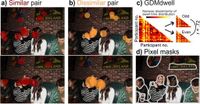When it comes to perceiving identical scenes, individual viewpoints can vary significantly, leading to divergent descriptions even among observers looking at the same image. A new study reveals that these differences are not merely subjective reflections, but are systematically influenced by individual gaze patterns. Conducted by researchers at Justus-Liebig University Giessen, Germany, this research investigates how observers’ fixation habits shape their verbal interpretations of visual stimuli.
The study involved 30 participants, averaging 22.77 years old, who viewed 100 natural scenes for three seconds each and then described what they saw. Their gaze patterns were captured, allowing researchers to generate a Gaze Dissimilarity Matrix (GDM) to quantify individual differences in gaze behavior versus their corresponding descriptions documented in a Description Dissimilarity Matrix (DDM). The results revealed a strong correlation between the similarities in gaze patterns and the similarities in their scene descriptions, particularly in the nouns used.
Notably, while the participants described scenes, some spent over four times as much time fixating on text elements compared to others. This variation extended to the naming of people or objects in the images, suggesting a complex interplay between attention and perception. The individual tendencies to focus on certain aspects of a scene profoundly affected how those scenes were articulated.
Using advanced eye-tracking technology, the study's conclusions point to significant implications for understanding visual perception in broader contexts, potentially impacting communication, education, and even marketing strategies. It highlights how our gaze is not just a passive observation tool but a fundamental influence on how we perceive and describe our visual world.
The findings indicate that these individual gaze patterns are predictive of naming behaviors across various contexts, suggesting a consistency that transcends the immediacy of the experiment. The systematic nature of these gaze-to-description relationships opens new avenues for research into the developmental and neurological underpinnings of visual perception.
Future research can delve into how these individual gaze biases might affect various populations, including children, individuals with autism spectrum disorders, or those in clinical settings, where variations in visual perception may lead to distinct communication styles.
As science continues to unravel the complexities of human perception, this study underscores the importance of understanding both how we see and how we articulate our experiences. Our gaze shapes our reality, and recognizing the nuanced differences in perception can enhance interpersonal communication and foster understanding in an increasingly visually driven world.

